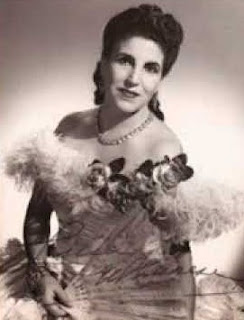Mario Del Monaco - tenor
Singer became famous for his interpretations of Otello
Opera singer Mario Del Monaco, who was renowned for the amazing power of his voice, was born on this day in 1915 in Florence. His family were musical and as a child he studied the violin but he developed a passion for singing as well. He studied at the Rossini Conservatory in Pesaro, where he first met and sang with the soprano Renata Tebaldi, who was to partner him regularly later in his career. Del Monaco made a big impact with his debut performance as Lieutenant Pinkerton in Puccini’s Madame Butterfly in Milan in 1940. He became popular with the audience at the Metropolitan Opera in New York in the 1950s, making many appearances in dramatic Verdi roles. He was one of the four Italian tenors at their peak in the 1950s and 1960s, sharing the limelight with Giuseppe Di Stefano, Carlo Bergonzi and Franco Corelli. Del Monaco became famous for his interpretation of the title role in Verdi’s Otello, which, it is estimated, he sang hundreds of times. He started making recordings for HMV in 1948 in Milan and was later partnered by Renata Tebaldi in a series of Verdi and Puccini operas recorded for Decca. Read more…
___________________________________________________________
Giosuè Carducci – poet and Nobel Prize winner
Writer used his poetry as a vehicle for his political views
Giosuè Carducci, the first Italian to receive the Nobel Prize in Literature, was born on this day in 1835 in Tuscany. Christened Giosuè Alessandro Giuseppe Carducci, he lived with his parents in the small village of Valdicastello in the province of Lucca. His father, a doctor, was an advocate of the unification of Italy and was involved with the Carbonari, a network of secret revolutionary groups. Because of his politics, the family was forced to move several times during Carducci’s childhood, eventually settling in Florence. During his time in college, Carducci became fascinated with the restrained style of Greek and Roman literature and his work as an adult often used the classical meters of such Latin poets as Horace and Virgil. He published his first collection of poems, Rime, in 1857. He married Elvira Menicucci in 1859 and they had four children. Carducci taught Greek at a high school in Pistoia and was then appointed as an Italian professor at the University of Bologna. Carducci was a popular lecturer and a fierce critic of literature and society. He was an atheist, whose political views were vehemently hostile to Christianity. Read more…
____________________________________________________________
Adolfo Celi – actor and director
Successful career of a Sicilian who was typecast as a baddy
An actor who specialised in playing the role of the villain in films, Adolfo Celi was born on this day in 1922 in Curcuraci, a hamlet in the province of Messina in Sicily. Celi was already prominent in Italian cinema, but he became internationally famous for his portrayal of Emilio Largo, James Bond’s adversary with the eye patch, in the 1965 film Thunderball. He had made his film debut after the Second World War in A Yank in Rome (Un americano in vacanza), in 1946. In the 1950s he moved to Brazil, where he co-founded the Teatro Brasiliero de Comedia. He was successful as a stage actor in Brazil and Argentina and also directed three films. Celi’s big break came when he played the villain in Philippe de Broca’s That Man from Rio. Afterwards he was cast as the camp commandant in the escape drama, Von Ryan’s Express, in which Frank Sinatra and Trevor Howard played prisoners of war. After appearing in Thunderball, Celi was offered scores of big parts as a villain. He later made a spoof of Thunderball in the film, OK Connery, in which he played opposite Sean Connery’s brother, Neil. Read more…
























